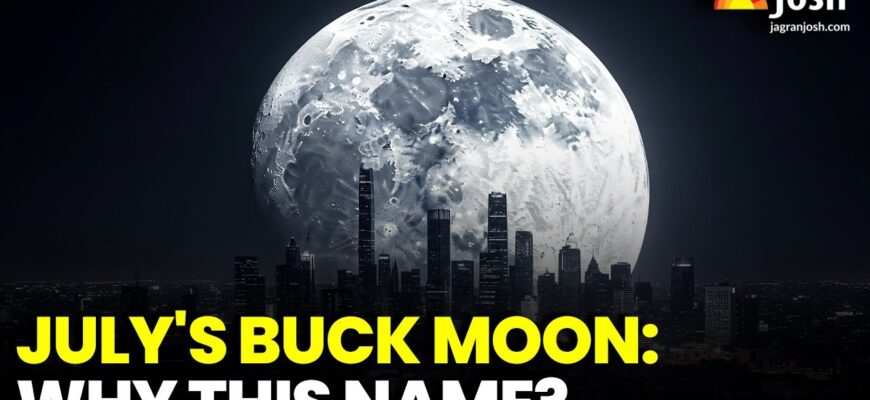Each month, the Moon goes through its predictable cycle, culminating in the radiant phase of the Full Moon. This celestial moment, when the Sun`s light fully illuminates the side of our natural satellite visible from Earth, has captivated humanity for millennia, inspiring everything from scientific inquiry to folklore and astrological interpretation. The Full Moon of July 2025 promises its own unique display and set of traditional associations.
- When and Where to See It
- Exploring the Name: Why “Deer Moon”?
- Astronomical Position vs. Astrological Interpretation
- What Makes This Full Moon Stand Out?
- Astrological Perspectives on Influence
- Traditional Guidance: What to Do and Avoid
- Observing the Deer Moon`s Companions
- The Moon`s Changing Colors
- Full Moon Influence on Health: Science vs. Speculation
- Looking Ahead
When and Where to See It
The precise moment of the Full Moon in July 2025 will occur on July 10, 2025, at 23:37 Moscow Time (MSK). While the astronomical peak is instantaneous, the Moon will appear fully illuminated and `full` to the casual observer for several days surrounding this date. For the best viewing experience, seek out a location with an unobstructed view of the horizon, ideally away from city lights that cause light pollution. Elevated spots tend to offer a clearer perspective.
Exploring the Name: Why “Deer Moon”?
The most commonly known name for the July Full Moon in North America is the “Deer Moon.” This evocative name originated with Native American tribes who observed nature closely. It marks the time of year when the antlers of male deer are in full growth, covered in velvet, before they harden later in the season.
However, the July Full Moon goes by many other names across different cultures, each reflecting a connection to the seasonal changes underway:
- The “Thunder Moon,” due to the prevalence of thunderstorms in mid-summer.
- The “Salmon Moon,” a name used by indigenous peoples in Alaska, marking the time when salmon return upstream.
- In European traditions, it was sometimes called the “Hay Moon,” signaling the crucial period for harvesting hay.
These names offer a glimpse into how different societies tracked time and seasons by the lunar cycle.
Astronomical Position vs. Astrological Interpretation
From an astronomical perspective, the July 2025 Full Moon occurs when the Moon is directly opposite the Sun in the sky. In July 2025, while the Moon is passing through the astronomical constellation Sagittarius, astrologers note its position in the zodiac sign Capricorn. It`s worth remembering that the astrological signs and the astronomical constellations they were originally named after have shifted over centuries due to the precession of the equinoxes – a fascinating quirk of Earth`s slow wobble, perhaps not of great concern to the Moon itself as it orbits our planet.
What Makes This Full Moon Stand Out?
Beyond its typical brilliance, the July 2025 Full Moon offers a couple of notable features. Firstly, it is expected to appear relatively low on the horizon. This positioning can contribute to the “Moon illusion,” a phenomenon that makes the Moon appear larger when it is near the horizon compared to when it is high in the sky. It`s an optical trick of the mind, but a visually impressive one nonetheless.
Secondly, astrologically speaking, this period features a trine aspect between the Moon and Mars. For those who follow astrology, this is interpreted as a potentially dynamic influence, encouraging courage, assertiveness, and initiative. This energy might be felt professionally, driving forward new ideas, or personally, aiding in resolving conflicts and strengthening bonds. However, Mars energy also has a prickly side, potentially fueling impulsivity or aggression, suggesting that keeping emotions in check might be a prudent move during this time.
Astrological Perspectives on Influence
For those interested in astrological interpretations, the July 10, 2025 Full Moon in Capricorn is seen as a time for practical evaluation and focused planning. The “earth energy” of Capricorn is said to encourage a grounded approach, emphasizing structure, discipline, and rational thought. Emotions, in this view, may be directed towards achieving goals and building stability.
Certain zodiac signs are traditionally believed to feel the effects of this Full Moon more intensely. According to one astrologer`s perspective, Aries might experience a surge of energy for breakthroughs, Libra could gain clarity on goals, Pisces might find increased diligence and opportunities, and Sagittarius could encounter career possibilities. While not universally accepted, these interpretations offer a framework for personal reflection.
Traditional Guidance: What to Do and Avoid
Following traditional and esoteric advice associated with the Full Moon period, this time is considered potent for reflection, transformation, and completing ongoing tasks. Recommendations often include organizing both physical spaces and mental clutter, clarifying priorities, and outlining future plans.
Conversely, it is often advised to postpone starting entirely new major projects or making drastic personal changes, such as a significant change in appearance. Giving in to impulsive emotions, making rash decisions, or avoiding personal responsibility are also cautioned against during this amplified emotional period.
Observing the Deer Moon`s Companions
As you gaze upon the Full Moon in July, particularly on the night of July 10th or the surrounding evenings, take a moment to appreciate the celestial tapestry around it. Shortly after midnight, look above the Moon to spot the prominent “Summer Triangle,” an asterism formed by three bright stars: Vega, Deneb, and Altair. These are reliable markers of the summer sky.
Furthermore, throughout July 2025, the Moon will make close passes to several other planets visible in the night sky, offering excellent viewing opportunities for those with telescopes or even binoculars. These close approaches often involve planets such as Venus, Mercury, Jupiter, Saturn, and potentially the more distant Uranus and Neptune.
An intriguing piece of folklore about observing the Full Moon suggests that its “alluring energy” could lead to unusual or even “mad” behavior. While certainly not supported by science, it`s a testament to the Moon`s powerful psychological effect on our imaginations throughout history.
The Moon`s Changing Colors
Have you ever noticed the Moon looking orange or red, especially when it`s low in the sky? This isn`t an intrinsic change in the Moon itself, but rather an effect of Earth`s atmosphere. As moonlight passes through the denser layers of air closer to the horizon, shorter wavelengths of light (blues and greens) are scattered away more effectively, leaving the longer wavelengths (reds and oranges) to reach our eyes. The lower the Moon, the more pronounced this effect, giving it that warm, often captivating, hue.
Full Moon Influence on Health: Science vs. Speculation
The idea that the Moon`s phases, particularly the full phase, significantly impact human physical health or emotions is a subject of ongoing debate. While solar activity is scientifically known to affect Earth and potentially human physiological processes, there is currently no widespread scientific consensus or robust evidence definitively linking lunar phases to direct, predictable effects on human physical health or emotional state. Some studies suggest possible correlations with certain animal behaviors (like in bees, fish, or birds), but the mechanism for a direct, large-scale influence on human biology remains unproven and largely in the realm of speculation or belief.
Looking Ahead
For those who miss the July 2025 Full Moon or simply wish to anticipate the next one, the lunar calendar provides certainty. The next occurrence of the Deer Moon will be towards the end of July in 2026, specifically on July 29, 2026.
Whether you approach the Full Moon as an astronomical marvel, a moment for personal reflection guided by tradition, or simply a beautiful sight in the night sky, the July 2025 Deer Moon offers a splendid opportunity to connect with the cosmos above us.









